Return of Singapore's Native Gingers
Hope for Singapore native gingers: grow them, save them!
Henry Nicholas Ridley, the first director of the Singapore Botanic Gardens (1888 - 1911), during his fieldwork conducted at various parts of Singapore, had the joy of seeing ample varieties of gingers and its allies.
Fast-forward some 120 years and here we are, with 11 species presumed nationally extinct, the remaining 14 species classified as critically endangered or endangered, and one considered 'only' vulnerable. Without timely intervention, the state of ginger affairs could hardly be expected to improve, due to the drying up of Singapore forests as well as the speed with which some alien plant species have spread in our nature parks and reserves.
A survey of Singapore's gingers
In 2010, hope for native gingers and its allies arrived in the form of Urban Research funding from the Centre for Urban Greenery and Ecology (CUGE), which kick-started a 15-month project that involved extensive surveys as well as establishing the germplasm of native ginger material. With several enthusiastic NParks colleagues from the Central Catchment Nature Reserve, we conducted over 40 surveys in Singapore's forested areas and managed to locate all the surviving native ginger species. We have marked over 150 populations or single adult individuals and monitored their flowering and fruit set.

Flowers of some of the Singapore native species and their current Red List status: Alpinia aquatica (CR, Hornstedtia conica (CR), Stachyphrynium latifolium (EN) and Cheilocostus globosus (NE)
.Animals just can't resist gingers!
Collecting ginger seeds proved to be a challenge as the often sweet-smelling and rather nice-tasting fruits attract various rodents and monkeys to feast on them. We have installed small wire-mesh cages to help us to get to the seeds before the animals do, at least in some cases, like in the case of critically endangered Spindle Ginger (Hornstedia conica).
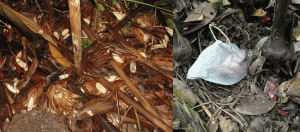
Hornstedtia conica– the white parts on the forest floor are fruit walls (left); infructescence protected by an aluminium mesh (right).
While it can be difficult to cultivate gingers during the early plantlet stage, we still can propagate meaningful numbers of plants to reintroduce them in the near future. We have, however, not yet found a way to deter wild boars, which persistently destroy entire plants of a beautiful but critically endangered ginger, Amomum xanthophlebium.
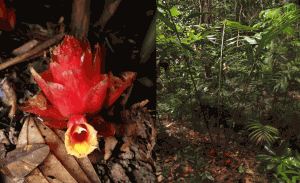
Amomum xanthophlebium(CR) – wild boars find the rhizomes of this species particularly yummy and would dig out entire plants, severely damaging the last few populations left in Singapore.
Reintroducing the gingers
By diligently collecting seeds, harvesting cuttings and seedlings from the wild, we have managed to establish a fairly large living germplasm of Singapore native gingers, which is lovingly cared for at the Singapore Botanic Gardens.
Establishment of in-vitro tissue culture germplasm is also ongoing at the Gardens. After propagating several species in larger quantities, in the past year, we have embarked on trials since last year to reintroduce these species in areas such as nature parks.
Before trail plantings, we walked through the selected parks to find suitable spots that meet these ginger plants' light and water requirements. Then, with the help of the respective park managers, nearly 300 plantlets (5 to 7 species per park) were grown in several locations, in areas such as Admiralty Park, Bukit Batok Nature Park, Yishun Park, Tampines Eco Green, and also in the grounds of the Singapore Botanic Gardens and the Istana. Ten species have been planted at various spots in Sungei Buloh Wetland Reserve and we have plans to reintroduce some species at Bukit Timah Nature Reserve and Dairy Farm Nature Park in early 2013.
Saving Singapore's gingers is like a marathon and we have only just started. But there is hope. Many caring NParks staff are willing to run for this cause. At the moment, in addition to reintroducing more ginger species into parks and nature reserves, we need to carefully monitor how they will take to their new environment, and if they will eventually be strong enough to propagate themselves in the field and fend off some of the fast-spreading alien species.
By Dr Jana Leong-Škorničková
|
The Ginger Garden: Singapore Botanic Gardens Pictorial Pocket Guide 2 Glossary |


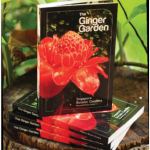
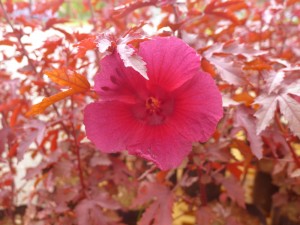
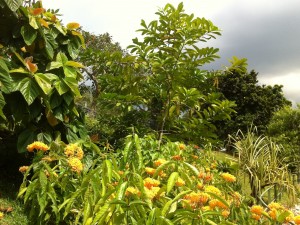
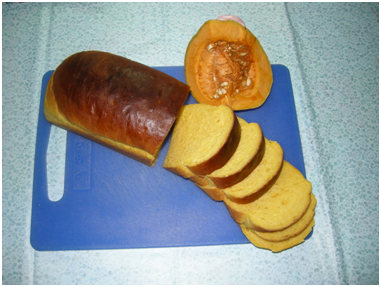
Have views or comments on this article? Let us know via this form. If you would like to give us feedback on any other areas relating to our parks and gardens, please submit via https://www.nparks.gov.sg/feedback